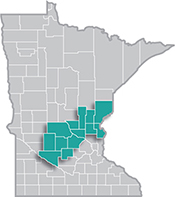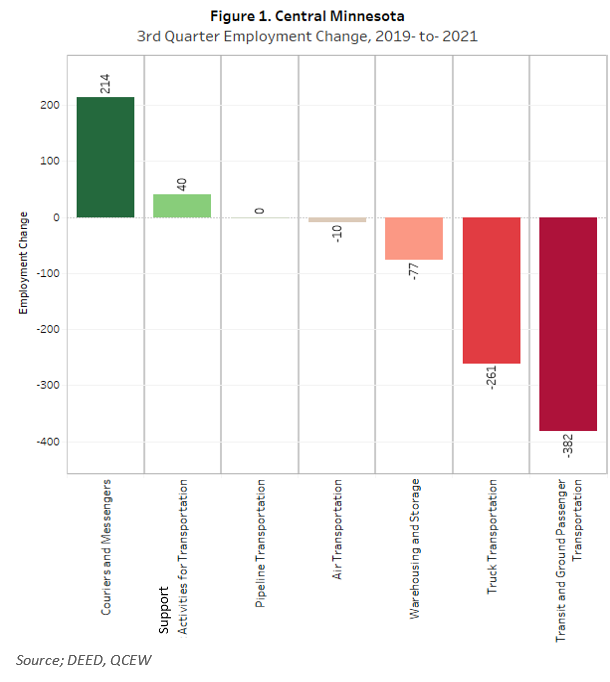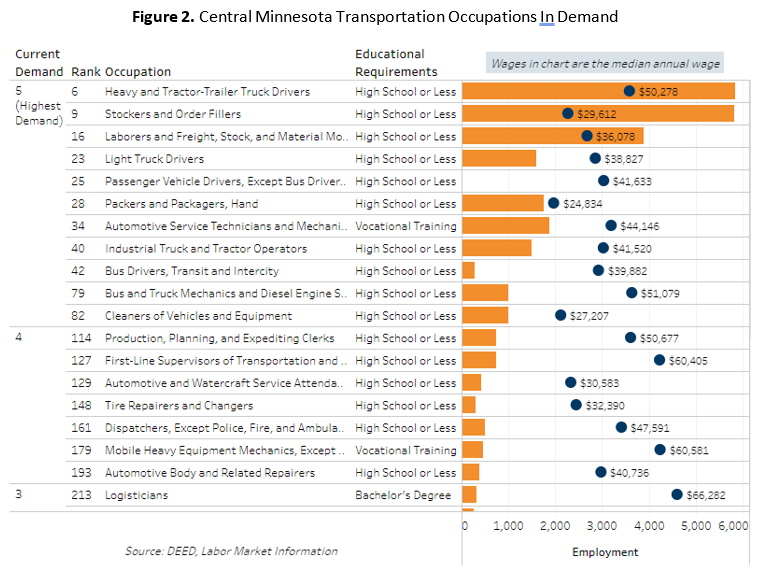 Central Minnesota is a manufacturing stronghold, with several global manufacturing firms operating there.
Central Minnesota is a manufacturing stronghold, with several global manufacturing firms operating there.
The region is especially well known for its expertise in food processing, printing, furniture manufacturing, appliances, machinery and heavy equipment manufacturing.
View our latest blogs on CareerForce. Want the freshest data delivered by email? Subscribe to our regional newsletters.
3/11/2022 9:00:00 AM
Luke Greiner
The Transportation industry has operated behind the scenes of our economy for decades to ensure goods and services are delivered and completed. But recently their importance and our reliance on the Transportation industry for all facets of our life has been brought to light in the wake of product shortages and long lead times during the pandemic.
Despite the demand, and even though it mostly escaped pandemic-related business restrictions such as those seen in Accommodation & Food Services and the related Arts, Entertainment & Recreation sectors, the Transportation industry still has found itself stubbornly below pre-pandemic employment levels. From the third quarter of 2019 to the third quarter of 2021, the Transportation & Warehousing industry reported 438 fewer jobs in Central Minnesota, a 4.6% decline. This is a larger decline than in the overall economy in the region, and an indication of one of the challenges to keeping shelves stocked.
Adding to the challenges, trucking companies were struggling to find workers prior to the pandemic, before the exodus of some 12,000 workers who have dropped out of the labor force in Central Minnesota from December of 2019 compared to December of 2021. Like almost every other sector, Transportation is feeling the labor shortage pinch now more than ever.
But like most things over the past two years, looking only at the big picture hides importance nuances. In the Transportation & Warehousing industry some segments boosted employment (+214 jobs at Couriers & Messenger companies) while other segments saw declines (-382 jobs at Transit & Ground Passenger Transportation companies and -261 jobs at Truck Transportation companies).
The Transit & Ground Passenger Transportation sector was hit especially hard, losing almost one in every five jobs over the two year period, more than double the percent decline experienced in the Accommodation & Food Services sector. Truck Transportation also lost a substantial share of jobs as evidenced by a 6% decline. Meanwhile the job gains at Courier & Messenger companies were a healthy +22% (see Figure 1).

Looking at the most recent Job Vacancy Survey, the Transportation & Material Moving occupation category had the third largest number of job openings in the region, with over 2,573 openings in Central Minnesota. That was well above the previous record number of openings (1,526 openings in the second quarter of 2019). The large number of openings and the drive to regain employment lost in 2020 has pushed many Transportation & Material Moving occupations into the highest category of Occupations in Demand in the region.
In fact, CDL Truck Drivers are now the sixth highest demand occupation in Central Minnesota, with close to 6,000 people currently employed and a healthy median annual wage of just over $50,000. CDL driving provides many workers with livable wages despite a low investment in training and education. It should also be noted that the employment and median wages in Figure 2 do not include the many self-employed truck drivers who likely find their wages significantly higher than what is shown in the chart. Other transportation-related occupations in high demand include Stockers & Order Fillers, Material Moving Laborers, and Light Truck Drivers (see Figure 2).

Contact Luke Greiner at 320-308-5378.